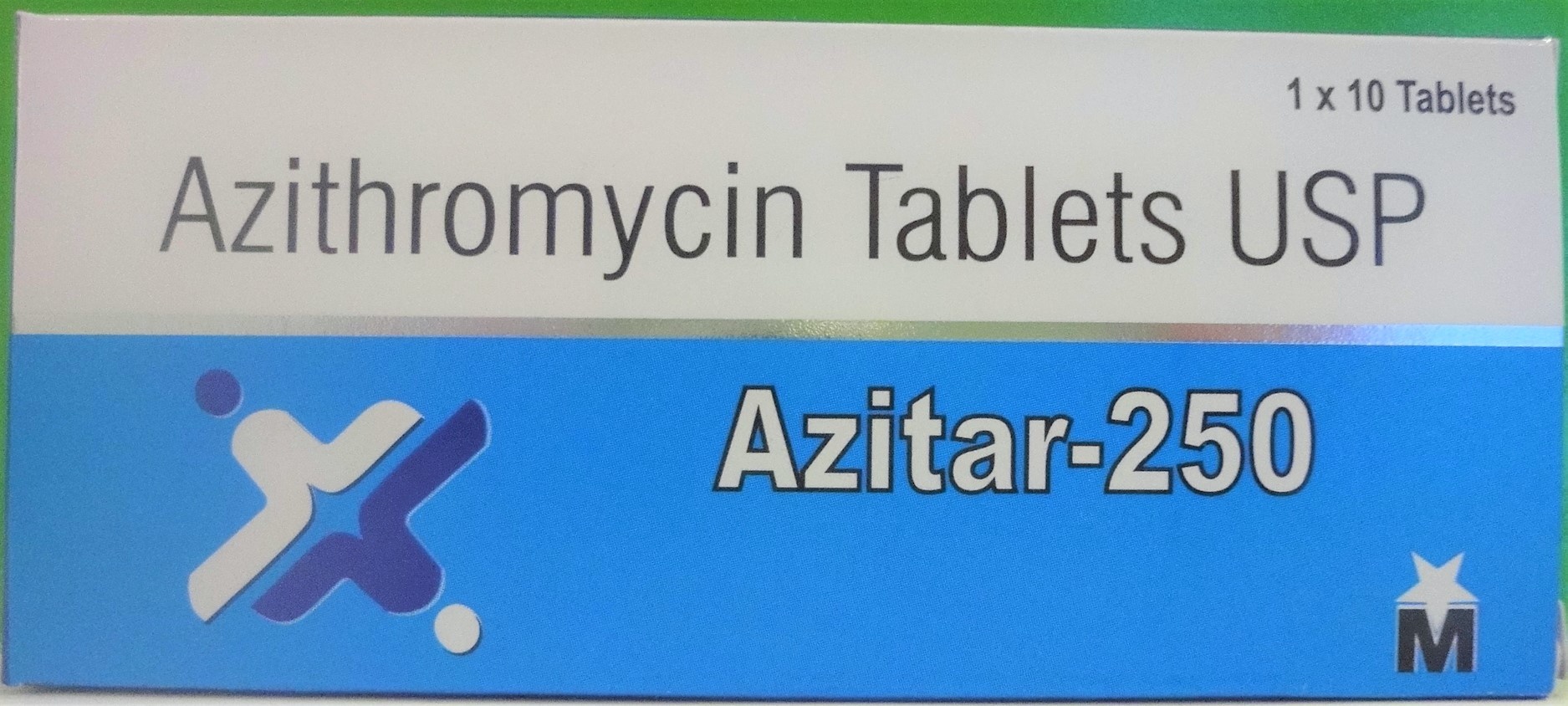AZITAR-250 Tablet
ក្រុមហ៊ុនផលិតឱសថ:
MAXTAR BIO-GENICS, India
ក្រុមហ៊ុនចែកចាយឱសថនៅប្រទេសកម្ពុជា:
Z.H.C.L.


- សារធាតុសកម្ម
- ប្រសិទ្ធិភាពព្យាបាល និង កម្រិតប្រើប្រាស់
- ហាមប្រើ
- ផលរំខាន
- អន្តរប្រតិកម្ម
- ស្ត្រីមានផ្ទៃពោះ និង ស្ត្រីបំបៅដោះកូន
- ការប្រុងប្រយ័ត្នជាពិសេស
- សកម្មភាពឱសថ បរិយាយប័ណ្ណឱសថ
-
សារធាតុសកម្ម
Azithromycin 250mg
-
ប្រសិទ្ធិភាពព្យាបាល និង កម្រិតប្រើប្រាស់
Treatment of infections caused by sensitive organisms.
Lower Respiratory Tract Infections: Community - acquired pneumonias, acute bacterial exacerbations of chronic obstructive pulmonary disease, acute bronchitis due to Haemophilus influenzae, Moraxella catarrhalis or Streptococcus pneumoniae.
Upper Respiratory Tract Infections: Ear, nose and throat infections e.g. tonsillitis, sinusitis, otitis media and pharyngitis.
Skin/Skin Structure Infections: Furunculosis, pyoderma and impetigo due to Staphylococcus aureus, S.pyogenes or S.agalactiae.
Sexually Transmitted Disease: Due to N.gonorrhoae and C.trachmatis.
Dosage
Mild to moderate Bacterial Exacerbations of Chronic Obstructive Pulmonary Disease, Pneumonia, Pharyngitis / Tonsillitis and Uncomplicated Skin and Skin Structure Infections (>15 years of age): 500mg as a single dose on the 1st day followed by 250mg once daily on days 2 through 5 for a total dose of 1.5g or 500mg once daily for 3 days.
Administer at least 1 hr before or 2 hrs after a meal. Azithromycin should not be taken with food.
-
ហាមប្រើ
Hypersensitivity to azithromycin, erythromycin or any macrolide antibiotic.
-
ផលរំខាន
Most adverse effects are mild to moderate in severity and are reversible upon discontinuation of azithromycin. Overall, the most common adverse effect in patients receiving the multiple - dose regimen was related to the gastrointestinal system with diarrhoea (5), nausea and abdominal pain (3%) being the most frequently reported. The following adverse reaction occurred in <1% of patients:
Cardiovascular: Palpitations and chest pain.
Gastrointestinal: Dyspepsia, flatulence, vomiting, melena and cholestatic jaundice.
Genitourinary: Moniliasis, vaginitis and nephritis.
Central Nervous System: Dizziness, vertigo, somnolence and fatigue.
Allergic: Rash, photosensitivity and angioedema.
-
អន្តរប្រតិកម្ម
Aluminium and magnesium containing antacids reduce the peak serum levels but not the extent of azithromycin absorption. Therefore, patients should be cautioned not to take the aluminium and magnesium containing antacids and azithromycin simultaneously.
Theophylline: Azithromycin did not affect the plasma levels or pharmacokinetics of theophylline administered as a single I.V. dose. However, concurrent use of macrolides and theophylline has been associated with increases in serum concentrations of theophylline.
Therefore, until further data is available, plasma theophylline levels must be carefully monitored in patients receiving azithromycin concomitantly.
Warfarin: Azithromycin does not affect the prothrombin time response to a single dose of warfarin. However, concurred use of macrolides and warfarin has been associated with increased anticoagulant effects. Prothrombin time should be carefully monitored in all patients being treated with azithromycin and warfarin concomitantly.
-
ស្ត្រីមានផ្ទៃពោះ និង ស្ត្រីបំបៅដោះកូន
Use in pregnancy: There are no adequate or well-controlled studies in pregnant women. Use during pregnancy only it clearly needed.
Use in lactation: It is not known whether azithromycin is excreted in breast milk. Exercise caution when administering to a nursing woman.
-
ការប្រុងប្រយ័ត្នជាពិសេស
Hepatic/Renal function impairment: Because azithromycin is principally eliminated via the liver, caution should be exercised when administered to patients with impaired hepatic function. There is no date regarding azithromycin usage in patients with renal impairment, however, caution should be exercised when prescribing azithromycin to these patients.
Use in the elderly: Pharmacokinetic parameters in older volunteers (65-85 years) were similar to those in younger volunteers (18-40 years) for the 5 day therapeutic regimen. Dosage adjustment does not appear to be necessary for older patients with normal renal and hepatic function receiving treatment with this dosage regimen.
-
សកម្មភាពឱសថ
The basic mechanism of action of azithromycin is inhibition of protein synthesis in the bacterial cell. Azithromycin binds reversibly to the 50S ribosomal subunit. This inhibits translocation of aminoacyl transfer - RNA and consequent protein synthesis.
*ព័ត៌មានឱសថត្រូវបានរៀបរៀងដោយ អ៊ីម៉ាតុគឹ មេឌីក (ខេមបូឌា) ដោយផ្អែកលើប្រភពព័ត៌មានខាងក្រោម។ សម្រាប់ព័ត៌មានលម្អិត សូមស្វែងរកនៅក្នុងក្រដាសព័ត៌មាននៃឱសថនីមួយៗ ឬ សាកសួរទៅកាន់ក្រុមហ៊ុនឱសថឬតំណាងចែកចាយនៃឱសថនីមួយៗ។
ប្រភពព័ត៌មាន៖
- ក្រដាសព័ត៌មាននៃឱសថសម្រាប់អ្នកជំនាញវេជ្ជសាស្ត្រដែលប្រើប្រាស់នៅប្រទេសជប៉ុន (Pharmaceutical and Medical Devices Agency, Pmda): https://www.pmda.go.jp
- ព័ត៌មានសង្ខេបនៃឱសថសម្រាប់អ្នកជំងឺដែលប្រើប្រាស់នៅប្រទេសជប៉ុន: http://www.rad-ar.or.jp
